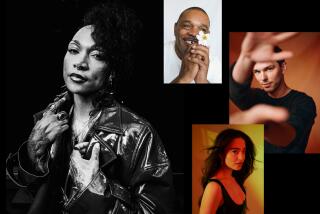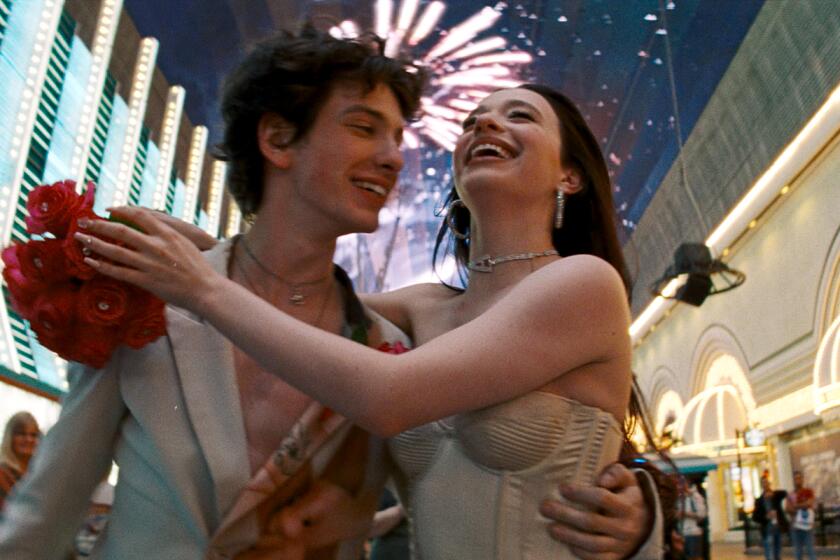You guys are beautiful
- Share via
“If we were a primitive society,” director Sydney Pollack said once upon a time, “movie stars would be gods.” Once upon a time in Hollywood they were. To judge by this summer’s film lineup, they still are.
This summer the gods and demigods of cinema are again convening for our pleasure. Sleekly polished, it is as impressive a pantheon of beauty seen since the studio system’s golden age, when MGM claimed to have “more stars than there are in the heavens.” This weekend Brad Pitt, Eric Bana and Orlando Bloom cross swords and destinies, vying for heartthrob ranking in “Troy.” Thereafter come the boys of cinema’s seemingly endless summer: Tom Cruise, Will Smith, Matt Damon, Jake Gyllenhaal, Joaquin Phoenix, Tobey Maguire, Colin Farrell, Mark Ruffalo, Benjamin Bratt, Guy Pearce and two of Asia’s biggest stars, Tony Leung Chiu-wai and Andy Lau. A few men -- Denzel Washington, Jeff Bridges, Clive Owen -- will also be in attendance.
Helen’s face launched a thousand ships; it’s likely that Brad Pitt’s face and famous torso have launched as many fan websites. This truism of modern movie marketing may rankle Pitt, a star with the soul of a character actor, a performer most comfortable hiding inside roles that obscure his beauty and standing in the shadows cast by his equally famous costars. But though the actor works hard to prove his onscreen chops and commitment, on the red carpet and in magazines -- in which he swears to his seriousness while posing without a shirt -- he plays the role of the star masterfully. These off-screen performances tacitly acknowledge the truth that Pitt sometimes seems at pains to deny: that the alchemical transformation of man into box-office gold involves not just talent but beauty.
Not just any beauty, but beauty that holds the screen -- possesses it. Hollywood was built on pulchritude, but for most of movie history our attention was principally focused on the desirability of its women, not its men. Norman Mailer wrote famously about Marlon Brando, but in the early 1970s he published a book about Marilyn Monroe.
In the decades since, the women’s and gay rights movements irrevocably altered how we look at men, on screen and off. Aided by new media outlets, these liberation movements freed the male body (or enslaved it, depending on your view), turning it into a socially acceptable field of desire and one very hot commodity. Finally, straight men could be exploited for their looks just like women by conforming to an ideal of beauty -- ripped and stripped of hair -- largely borrowed from gay culture.
Gay or not, male actors and stars are more brazenly sexualized now, namely because they’re also more feminized. In the past, Hollywood stars were unmistakably he-men; these days, they all whisper come hither like hard-bodied Marilyns. Describing how the studios created stars, MGM publicity photographer Bud Graybill once explained that when newcomer Robert Taylor arrived at the studio in the 1930s, “He was such a beautiful guy ... that he looked more like a girl. They [MGM] worked him in the gym until he came out with broad shoulders; he became a great horseman and was able to make great westerns. You’d photograph him smoking a pipe, wearing heavy cardigans, doing pictures like ‘Stand Up and Fight’ -- all to make him more masculine in appeal, like Gable.... It was a business in those days -- they were manufacturing a star.”
They still are -- only these days the “they” also includes fleets of support staff and an insatiable media that reports a star’s every hiccup as if it were news, because, right or wrong, it is. The system is a hungry beast. As media outlets have proliferated so too have the number of stars and stars manque (or is it the other way around?); now everyone’s in the entertainment industry. In an age of instant celebrity and broadcast narcissism, reality-show survivors enjoy their 15 minutes on every conceivable media platform. If you can’t be a star, you can always play one on your website. Even weirder, if you can’t be Brad Pitt, you can always undergo plastic surgery to look (not in their dreams, not even close) like him, as two lost souls recently tried to do on MTV’s creepy sur-reality show, “I Want a Famous Face.”
The conceit of a regular Joe going under the knife to look like a movie star sounds like a future-shock scenario from William Gibson’s 1986 science-fiction novel “Count Zero.” At one point, a man looks into a woman’s face expecting to see “a routine beauty, bred out of cheap elective surgery and the relentless Darwinism of fashion, an archetype cooked down from the major media faces of the previous five years.”
Two decades after the publication of Gibson’s book, Botox and other medical miracles -- along with digital wizardry -- have closed the distance between the novelist’s imaginary future and our present, nowhere more obviously than at the movies. More and more, wrinkles are as rare in American film as hen’s teeth -- as rare as pouchy eyes, wattled jowls and poignantly sagging all-too-human flesh.
It’s hard to imagine stars such as Pitt (age 40), Cruise (41) and Washington (49) letting the years wash over them as voluptuously and with as little visible self-consciousness as Jack Nicholson has. They couldn’t afford the creases and bulges, and neither can the system. All three younger men are fine actors and superb stars, but the world of big-studio filmmaking no longer allows for much variation either in movies or masculinity. That’s why indie film exists. That’s also why Pitt strapped on gladiatorial gear for “Troy” and is shooting “Ocean’s 12.” Why Washington stars in Jonathan Demme’s coming remake of “The Manchurian Candidate.” And why Cruise -- despite recent attempts to lose his Tom Terrific smile in vehicles like “The Last Samurai” -- begins filming “Mission: Impossible 3” in late summer.
Warner Bros., the studio that is releasing the Wolfgang Petersen-directed epic, “Troy,” on Friday, entertains high hopes that moviegoers have eyes for no one but Pitt and co-stars Bana and Bloom, the main attractions in what looks like a classic edition of People’s Sexiest Man Alive issue. The image of the bronzed and bulked-up Pitt in a flirty skirt has been catnip to purveyors of male movie beauty since the release of the film’s first poster. Although Greek pottery often presents a distinctly unglamorous vision of Achilles with reedy limbs and a fishhook chin, in “The Iliad” Homer observes that the Athenian warrior has “red-gold” hair, which dovetails perfectly with “Troy’s” gilded movie-god vision of Pitt. (The poet also states that he has a “shaggy chest,” words that summon up the rather more mortal image of Robin Williams.)
If Achilles looked anything like Pitt does in “Troy” it’s entirely possible that Paris, played by the equally comely Orlando Bloom, wouldn’t have given Helen a second look. I mean no offense to Diane Kruger, the lovely unknown who plays the Spartan queen. It’s just that if Paris -- the Trojan prince who either stole or seduced Helen away from the Greeks, thereby launching a war and all those ships -- had seen Pitt in his “Troy”-boy glory he wouldn’t have had eyes for anyone else. The Trojans may not have had a name for such passion; the Greeks certainly did. Still, this being Hollywood, not swinging antiquity, male bonding in “Troy” will probably play out on the battleground rather than the bedroom, which, perhaps, helps explain why all the male leads are played by familiar names while most of the female roles are not.
This movie season two things seem clear: The summer belongs to the guys, and, increasingly, male stars don’t just keep the action going -- they are the main objects of our desire. There’s nothing wrong with that, for the most part. Whether they belong to pretty Robert Taylor or prettier Jude Law, beautiful faces keep us coming back to the movies. And getting lost in that kind of beauty -- losing your bearings in the landscape of perfection that is Cary Grant’s face in Hitchcock’s 1946 thriller, “Notorious” -- is one reason movies were invented.
They don’t make stars or glamour like that anymore, but some directors try. “I lit him like Rita Hayworth,” Steven Soderbergh said of George Clooney, whose physical charms the director captured in “Out of Sight,” launching the TV actor on the road to movie stardom. Jennifer Lopez, Clooney’s co-star in “Out of Sight,” looked pretty good too, but hers isn’t the face we remember from that movie. And, with so many pretty men, who needs pretty women? The time when male stars could look like Elliott Gould, Donald Sutherland or even craggy Humphrey Bogart seems past. The movies continue to yield such untempered beauties as Adrien Brody and Benicio Del Toro, but these seem exceptions. Strangely, it has become easier for Adam Sandler to get the girl than it is for a dramatic star who looks like Brody or Del Toro, neither of whom has been positioned as romantic leads. How this bodes for an interesting, unpredictable film future remains an open question.
Meanwhile, it’s summertime and the viewing is easy. Brad’s in a skirt and slinging a sword and all is right -- or, at least, really hot -- in the movie world.
Manohla Dargis is a Times film critic. Responses can be e-mailed to [email protected].
More to Read
Only good movies
Get the Indie Focus newsletter, Mark Olsen's weekly guide to the world of cinema.
You may occasionally receive promotional content from the Los Angeles Times.










